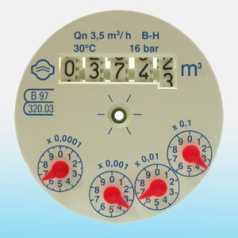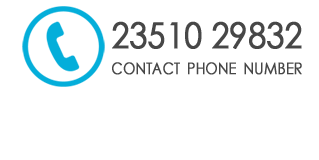Single jet turbine water meter, straight reading on 5-digit roller counter
DBRF model for cold water, liquid-filled sealed counter type, measuring range R80 and R160, temperature classes 30°C and 50°C
|
Nominal size of the meter |
15 - 1/2 |
20 - 3/4 |
25 - 1 |
| Q3 |
Permanent flow rate m³/h |
25 |
40 |
63 |
| Q4 |
Maximum flow rate for short period m³/h |
3.125 |
50 |
7.875 |
| Q2 |
Transitional flow rate with measuring range R80 [MPE ±2%] l/h |
50 |
80 |
126 |
| Q1 |
Minimum flow rate with measuring range R80 [MPE ±5%] l/h |
3.125 |
50 |
7.875 |
| Q2 |
Transitional flow rate with measuring range R160 [MPE ±2%] l/h |
25 |
40 |
63 |
| Q1 |
Minimum flow rate with measuring range R160 [MPE ±5%] l/h |
1.563 |
25 |
3.938 |
| S |
Accuracy at measuring range R80 l/h |
10 |
15 |
20 |
| S |
Accuracy at measuring range R160 l/h |
5 |
8 |
8 |
| ΔP |
Pressure loss class bar |
63 |
63 |
63 |
| MAP |
Maximum allowed working pressure bar |
16 |
16 |
16 |
| |
Dial register from/to m³ |
0,0001/100.00 |
0,0001/100.00 |
0,0001/100.00 |
| A |
Lenght without couplings mm |
110-115 |
130 |
160 |
| |
Lenght with couplings mm |
190-195 |
228 |
260 |
| C |
Height with open lid mm |
150 |
150 |
185 |
| D |
Height with closed lid mm |
83 |
83 |
103 |
| B |
Maximum diameter mm |
80 |
80 |
100 |
| E |
Height of tube mm |
24 |
24 |
34 |
| |
Weight with couplings kg |
850 |
1.100 |
1.750 |
| |
Weight without couplings kg |
690 |
860 |
1.280 |
For a correct installation of the water meters You are required to follow these instructions:
1. polish accurately the two tube sections where the meter has to be installed (especially if it is a new plant) , removing foreign substances (like hemp filaments, calcareous sediments, welding slags and so on..), let water flows for some minutes by connecting a threaded tube having the same length of the water meter to the main connection;
2. install the water meter perfectly horizontal being sure the water flow is in the direction of the arrow stamped on the meter body.
The horizontal installation is very important for a good performance and must be checked in longitude and transversally;
3. install the meter in a place protected by freezing, eventually cover it with insulating material;
4. install it in position guaranteeing an easy reading, protected by shocks and tampering;
5. it is better to avoid water meters installation immediately after equipments or tubes which may cause water beddies and an irregular flow of the water, they may cause a bad accuracy. In this case it is suggested to install the water meter with distance of at least 10 times the water meter diameter far from valves, flood gates, cocks, portion of curved or throated tubes and as far as possible from thrust equipments as pumps, autoclaves;
6. install the water meter between two taps, to allow, in case of maintenance, an easy removal. The downstream tap should be able to discharge the water to empty the meters in case of frost or in case of removal for maintenance.
Please note: to keep all meter components in good working conditions, we recommend to ensure that the meters are always full of water (with the exception of short periods only for maintenance).
The water meter, being a measuring instrument, is used to determine visually, by the dial, the volume of water passed inside it; it is necessary so, for its correct use, to know how to read the dial.
The rolling numbers show the cubic meters -the last to the right is bigger in order to make the reading easier when is coming the next number-
The red pointers of the little dials show the submultiples of the cubic meters and, making the transformation of the cubic meter, you can get the reading in litres –0.001 cubic meter=1 litre) What’s more, the little dial marked with x 0.0001 has the double division to read up the twentieth part of a liter, for higher precision (see Picture 1).

Pic. 1
For example the dial, shown in picture 1, reads a value of 3742 cube meters (the last rolling number is halfway between the number 2 and the number 3, therefore the lowest numerical number must be taken into account).
On the other hand, the little dials show:
1. dial marked by x 0,1: value 3 (being halfway between 3 and 4), equal to 0,3 m³, i.e. 300 litres
2. dial marked by x 0,01: value 6 (being halfway between 6 and 7), equal to 0,06 m³, i.e. 60 litres
3. dial marked by x 0,001: value 3 ( being halfway between 3 and 4), equal to 0,003 m³, i.e. 3 litres
4. dial marked by x 0,0001: value 6,6 (being slightly forward, as compared to the halfway between 6 and 7), therefore 0,00066 m³, i.e. 6,6 decilitre
The sum of all the above value is :
3.742,36366 m³
Usually, when reading is made for invoicing, the municipalities take into account just the digits before the comma, I.e., cube meters only.






